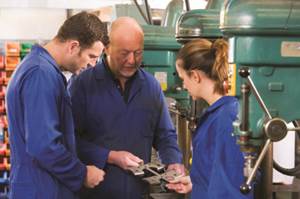Why Is Additive Manufacturing Important?
One of the important ideas showcased in this year’s Emerging Technology Center is additive manufacturing. 3D Systems, ExOne, Objet and Renishaw are all companies exhibiting in the ETC, located in Booth N-650.
This part was produced by Cleveland-area plastics manufacturer Thogus. The order quantity was so low that the job was not a candidate for molding. Thogus made the parts on additive manufacturing machines instead.
One of the important ideas showcased in this year’s Emerging Technology Center is additive manufacturing. 3D Systems, ExOne, Objet and Renishaw are all companies exhibiting in the ETC, located in Booth N-650. These companies offer varied technologies, but what their systems all have in common is making parts by adding material instead of cutting it away. That is, equipment from these companies builds complex 3D forms by precisely adding material in, layer upon layer. Metal or plastic components can be made this way. Compared to traditional methods, this approach to part making might seem strange, but manufacturers in the aerospace and medical industries, among others, are already making some components additively and moving other components toward additive production. In these applications, does additive technology take the place of CNC machining?
Sometimes, yes. But in the much larger share of cases where additive manufacturing succeeds, it does so by producing forms that cannot be made practically in any other way. The promise of additive manufacturing is found not in its potential to replace machining of any existing process, but in its potential to extend the capabilities of manufacturing.
Today, the most established use of additive manufacturing is making prototypes. 3D printers can produce complex pieces in small quantities quickly for the purpose of evaluating a design. Mold makers and plastics processors frequently use additive equipment in precisely this way—to prove a part before the tooling is finalized and before full-scale production begins. However, now that additive equipment is increasingly demonstrating its effectiveness for making pieces that are precise enough and resilient enough for end-use application, additive manufacturing promises to deliver many more advantages as well.
Those advantages include:
- Design freedom. In machining, casting or molding, complexity is costly. Every complex detail has to be produced through additional tool paths or other extra steps. By comparison, part complexity in additive manufacturing adds little or no extra consideration. Forms can be created that would be impractical or unthinkable in other processes. A part can be made purely for functionality, without manufacturing-related constraints. Design engineers have only started to explore the implications of this.
- Low-quantity economy. An additive process does not require hard tooling to be produced or assembled, and it includes little in the way of setup time. As a result, there are not the typical production-related costs that often require a large production run in order to justify them. Additive processes permit very short runs—including one piece—to be printed cost-effectively.
- Material efficiency. Additive manufactured parts, particularly metal ones, still get machined. The additive cycle alone often can’t deliver the final details, dimensions and finish that a critical part demands. However, among all of the near-net-shape processes, additive manufacturing is nearest to net. The amount of material that has to be sacrificed to follow-up machining is slight.
- Predictable production. Build time in additive manufacturing is often directly predictable from the part design. This means production time can be known to a fine level of precision. As additive manufacturing spreads, manufacturers will achieve much tighter control over their production scheduling.
- Reduced assembly. This is the game-changer for many established products to which an additive production process is introduced. The complex form created through additive manufacturing can be a single piece that replaces what is currently an assembly of many pieces. That means the savings from the additive process include eliminating all of the effort that used to go into that assembly, as well as the fasteners, brazing or welding that used to be involved, and all the extra features and material that once were added to the design solely for the sake of the assembly operations.
Related Content
Understanding The Four Major Behavioral Styles
Companies today are expanding the role of teams in the workplace in an effort to empower employees and improve organizational effectiveness. The more we try to work as a team, the more important it becomes to recognize that people exhibit different behavioral styles.
Read MoreKey CNC Concept No. 1—The Fundamentals Of Computer Numerical Control
Though the thrust of this presentation is to teach you CNC usage, it helps to understand why these sophisticated machines are so important. Here are but a few of the more important benefits offered by CNC equipment.
Read MoreA New Milling 101: Milling Forces and Formulas
The forces involved in the milling process can be quantified, thus allowing mathematical tools to predict and control these forces. Formulas for calculating these forces accurately make it possible to optimize the quality of milling operations.
Read More6 Steps to Take Before Creating a CNC Program
Any time saved by skipping preparation for programming can be easily lost when the program makes it to the machine. Follow these steps to ensure success.
Read MoreRead Next
3 Mistakes That Cause CNC Programs to Fail
Despite enhancements to manufacturing technology, there are still issues today that can cause programs to fail. These failures can cause lost time, scrapped parts, damaged machines and even injured operators.
Read MoreThe Cut Scene: The Finer Details of Large-Format Machining
Small details and features can have an outsized impact on large parts, such as Barbco’s collapsible utility drill head.
Read More
.jpg;width=70;height=70;mode=crop)









.png;maxWidth=300;quality=90)















